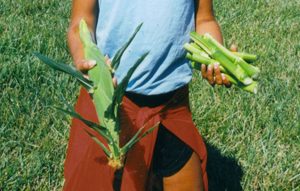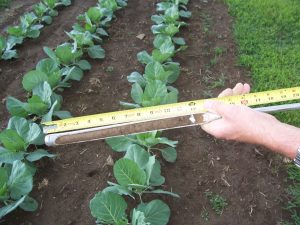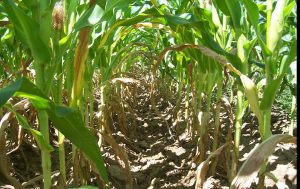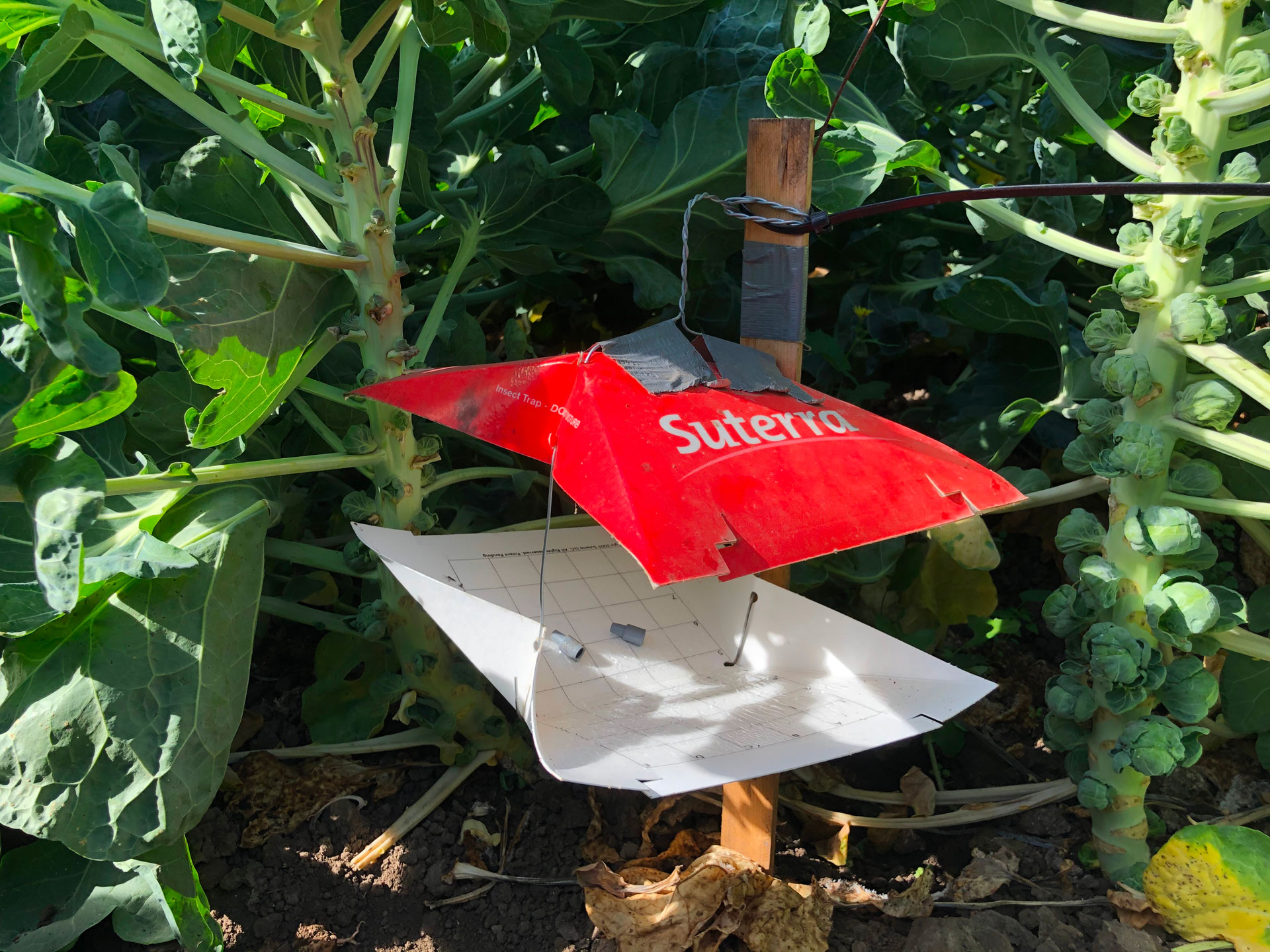
Sweet corn is a heavy feeder on soil nitrogen (N). A full-season sweet corn variety may uptake about 125 lbs. N per acre in the stover, and about 50 lbs. N is removed by harvest of marketable ears. Thus, before organic growers crop a field to sweet corn, they should build up the capacity of the soil to supply N.
Because there are no cheap and readily available approved N sources for supplying supplemental N during the early growing season, it is important to design an organic farm plan that will minimize the need to apply sidedress N fertilizer for production of organic sweet corn. Crop rotations, legume cover crops, manures and compost are commonly used organic methods and inputs to achieve a goal of soil N sufficiency.
Help the Crop Early On
At the time of planting, a small amount of an organic fertilizer may be placed near the seed row. This strategic placement is intended to get the crop off to an early start when the root system is limited.

Once the corn plants are about six inches tall, it is the beginning of a very rapid vegetative growth phase where the crop has a high daily uptake demand for N. The peak uptake rate for N may exceed 3 lbs. N per acre per day. During this critical period of rapid growth, the soil under organic farming management must have the capacity to supply sufficient N to match the needs of the crop.
One way to access the soil N availability at this critical growth stage is to test the soil for nitrate-N in the surface 12 inches of soil. This soil test method is commonly referred to as the Pre-Sidedress Soil Nitrate Test (PSNT). The concept behind the test was first developed on grain and silage corn, but research has demonstrated that this soil test can be applied effectively to sweet corn and a wider range of annual vegetable crops such as cabbage.
The PSNT is a soil test where the soil sampling is performed during the early growing season. It is most useful in fields where one might expect, based on good soil building cultural practices, that the soil can be predicted to supply sufficient N to take the crop to maturity. Thus, the purpose of this early season soil test for N is to make predictions about projected N availability for the remainder of the growing season.
If the PSNT soil test finds a 25-ppm-or-higher level of nitrate-N in the soil, the field is considered adequate and no supplemental or sidedress N fertilizer would be recommended. When growers test and find this level of available soil N early in the growing season, it gives confidence to growers that their N fertility program is on target.
On the other hand, if the PSNT soil test finds less than 25 ppm of nitrate-N in the soil, the field is considered deficient and sidedress N fertilizer would be recommended. Hopefully this is not a common occurrence for organic sweet corn growers, but if it happens, they may sidedress with pelleted poultry manure or some other approved N fertilizer.
Conceptually, the PSNT soil test is a good diagnostic tool use for organic crop production. Under good organic farming management, the PSNT is useful to measure and hopefully confirm that the soil has the capacity to supply sufficient N and produce a good crop yield of sweet corn. This gives the organic grower confidence in their soil building and cultural management practices.
On low-organic-matter-content soils and where farming systems neglect to use soil fertility building practices as well as where there is not a strong focus on building up a healthy biological capacity to supply N to crops, it is generally a waste of time to use the PSNT soil test. This is because such fields will almost invariably have low soil test values as measured by the PSNT, and this can be predicted without performing a PSNT soil test.

In most cases under good organic farming management, the PSNT soil test should find 25 ppm or above for nitrate nitrogen. As previously stated, if the PSNT soil test finds less than 25 ppm, the grower can still apply some supplemental N fertilizer. A situation where N deficient soils might be found is where a heavy leaching rain washes available N from the soil before the PSNT soil sample was collected.
Occasionally, an organic grower might, when using the PSNT soil test, find exceptionally high levels (greater than 50 ppm) of nitrate-N. In this hopefully rare instance, this may be interpreted as a sign that the organic grower used a combination of manures, composts and legume rotations to supply excess N. The grower can learn from this experience and adjust their soil fertility building program accordingly in future growing seasons.
Carrying Out a PSNT Soil Test
Details on how to carry out the PSNT soil test are available by web search for a fact sheet at Rutgers New Jersey Agriculture Experiment Station: “Soil Nitrate Testing as a Guide to Nitrogen Management for Vegetable Crops”.

Briefly, for sweet corn, soil samples are collected when plants are about six inches tall by collecting soil cores between the rows. The soil sample probe for this special test needs to be able to collect the soil sample cores from the 0- to 12-inch depth (note that this is a deeper sampling depth than for a traditional soil fertility test.) Collect about 15 cores from the field area of interest. The soil sample needs to be dried shortly after collection to stop soil metabolism which could otherwise change nitrate-N concentrations. Soil samples can be dried quickly in an oven or overnight by placing the soil in a thin layer in pan inside of a warm greenhouse. Send the sample off to a soil testing laboratory that can report results back to the grower quickly. A fast turnaround for reporting is needed because if by chance the soil test finds that N is deficient, the grower will want to immediately take corrective action by adding supplemental N fertilizer.
Soil test kits for nitrate, designed for use on the farm, may be used as an alternative to sending soil samples out to a laboratory.
Note that interpretations for the PSNT may vary slightly among states, so check with your local state extension service. Nevertheless, there is good consensus among researchers that the critical PSNT soil test level is near 25 ppm nitrate-N for field corn, sweet corn and cabbage.
Unique Organic Fertility
Another point of consideration is the unique fertility situation of soils under organic management. Approaches to building soil fertility, the nutrient sources and the tillage systems are often quite different for organic versus conventional production systems. After long-term management under the contrasting systems, especially because of organic matter accumulation, the soils may become more biologically active and different enough that agronomic test results may need reconsideration. Soil fertility test interpretations as developed from research conducted under conventional farming are generally assumed to be transferable for use in organic systems. However, most soil testing standards were developed under non-organic farm management, and that is about the only database we currently have until more soil fertility test research is conducted on certified organic farms.
Another indicator of when corn is provided with excessive amounts of N from soil or fertilizer is by use of a stalk tissue test. Corn plants typically have good green color just as should be expected for optimally fertilized corn. However, excessive N supply and N uptake are not so easy to visually diagnose by crop appearance alone. A good diagnostic test for excess N fertilization of sweet corn is the “End-of-Season Stalk N Test”. This plant tissue test is performed at harvest time. At this stage, it is too late to take corrective action during the current growing season; however, a grower can learn from experience if year after year they are providing excessive N. With this “report card” information about their production practices, they can learn to adjust their fertility program in subsequent growing seasons.
In the case of N deficiency, stalk N testing in sweet corn is not useful because the symptoms of N deficiency in corn (yellowing of the older leaves and small ear size) are readily apparent without performing a test. Classic symptoms for N deficiency appear first on lower leaves as yellowing and in severe cases as a dead tissue with a V-shaped pattern from the leaf tip to midvein.
To perform the corn stalk tissue test, collect samples of stalk tissue by cutting and collecting segments of the stalk at harvest time. Do not delay sample collection; sampling must be performed on the same day as sweet corn ear harvest. Cut stalk segments at 6 and 14 inches above the ground. Remove outer leafy plant tissue and collect about ten or more stalk segments from the field area of interest. Dry the samples and send them to a lab for analysis for total N concentration.
Interpret results as follows: sweet corn stalk samples with 1.6% to 2.2% N are regarded to be in the optimum range, and stalk samples testing above 2.2% N are regarded as having too much N and are a sign of overfertilization.
Details on how to use this tissue test are available by web search at Rutgers New Jersey Agriculture Experiment Station: “Sweet Corn Crop Nitrogen Status Evaluation by Stalk Testing”.
Other Nutrients
Besides N, sweet corn needs a proper balance of all essential plant nutrients. Fields intended for sweet corn should be sampled and tested to ensure that P and K fertility levels are at or near optimum levels. The target soil pH level for sweet corn is 6.5. Applications of limestone as recommended by soil test reports should supply any needed calcium (Ca) or magnesium (Mg). Sulfur (S) is an important nutrient for both yield and enhancement of sweet corn flavor. Fields with very sandy soils are most likely to be S deficient. Organic growers who frequently apply manures or compost will generally have enough S fertility from the soil. The need for micronutrients can be assessed from soil tests. Boron (B) is an important nutrient for pollination and good kernel fill at the ear tip. Manganese (Mn) deficiency sometimes occurs on sandy soils. Foliar applications of manganese sulfate (1 lb. Mn/acre) can correct a Mn deficiency.
Amount of nutrient removal by crop harvest is a useful indicator for sustainable nutrient management. For sweet corn, we have data to show how much macro and micronutrients are removed with every harvest of sweet corn. Depending on whether sweet corn is grown for direct marketing, wholesale or processing, growers may use different units to express yield. Thus, the nutrient removal values can be expressed both in units of ear number and weight.
A crate typically consists of 50 ears as a market unit. Whether expressed as per 1,000 ears, hundredweight (100 lbs. = 1 cwt), or crate (50 ears), nutrient management planners can scale nutrient removal values up to a yield goal per unit land area by multiplication. As an example, for nutrient removal data we will assume a typical full season variety of sweet corn. And assume the yield level = 150 cwt/acre (or about 18,396 ears/acre or about 368 crates). (This example assumes weight of a one typical fresh sweet corn ear of market size with green husk included equals 0.815 pounds.) This full-season variety of 18,396 ears harvested fresh would be projected to remove in lbs. per acre: N, 51; P, 9.1; K, 34; S, 3.7; Ca, 2.0; Mg, 3.9; B, 0.024; Cu, 0.014; Fe, 0.09; Mn, 0.044; and Zn, 0.072. Nutrient removal values would be somewhat less for a shorter season sweet corn variety.





